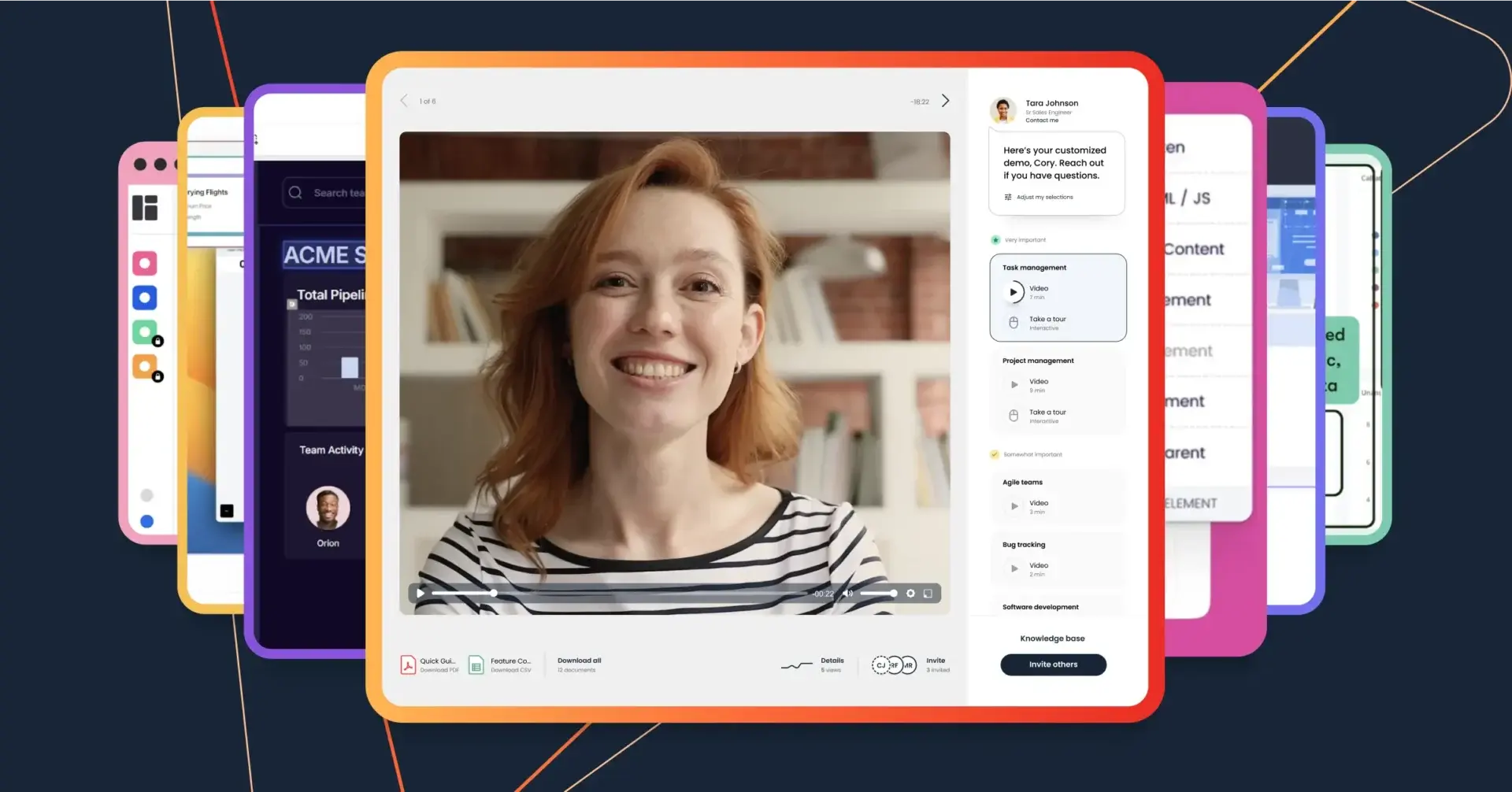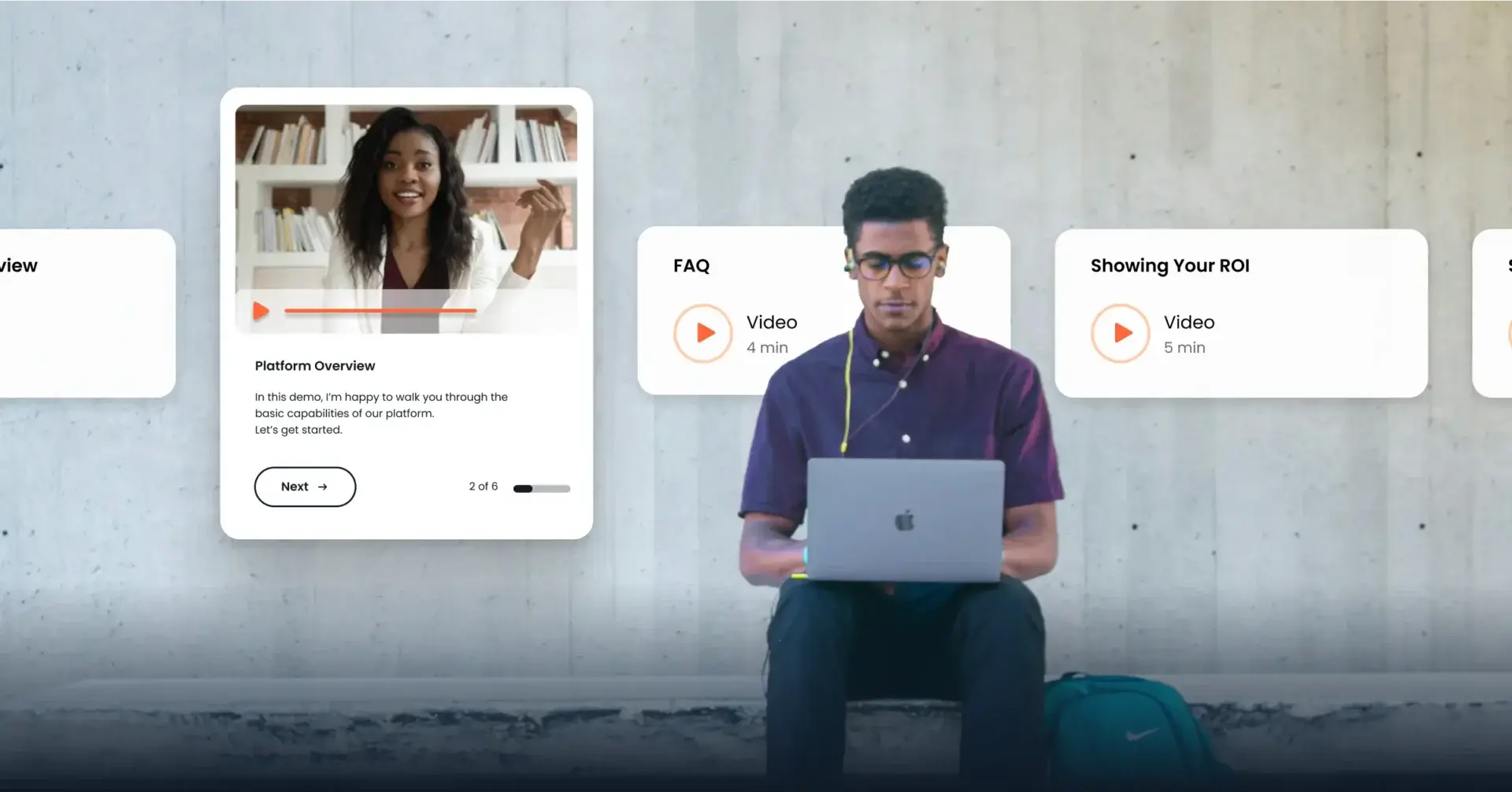We’ve all felt it: B2B selling has slowed to a crawl. The average sales cycle now stretches past six months—and that’s just the deals that close. Others stall out in email purgatory, lose momentum in internal stakeholder debates, or get scooped up by faster-moving competitors.
Meanwhile, your team’s working harder than ever, chasing leads, building decks, customizing demos…and still seeing deal velocity slow down.
Why?
Buyers have flipped the script. They’re more informed, more self-directed, and more skeptical than ever. They’re forming internal buying committees, doing extensive research before ever talking to a rep, and ghosting at the first sign of friction. They want speed and simplicity. They expect personalized value, right now—not after three meetings and a PDF follow-up.
But sellers? They’re still trying to navigate a buyer journey that’s murkier and more chaotic than ever before. They’re guessing at engagement, chasing stakeholders who aren’t ready, and reacting instead of leading. And all the while, deal velocity slows to a crawl, dragging down pipeline health, forecasting accuracy, and revenue growth.
Here’s the kicker: This isn’t a buyer problem—it’s a process problem. And it’s one we can solve.
Deal velocity—the speed at which a deal moves from initial contact to close—isn’t just a nice metric for dashboards. It’s a make-or-break lever for modern revenue teams. When it’s high, you close more business, faster, with fewer resources. When it’s low, even the best deals rot on the vine.
So, how do we increase deal velocity in a buyer-controlled world?
It starts with shifting from seller-led processes to buyer-enabled product experiences. It means giving prospects the tools to explore your product on their own time, bringing in stakeholders earlier, and surfacing buying intent before your team invests hours in a demo. It means clarity, consistency, and control—not just for your reps, but for your buyers, too.
Because when you align with how modern buyers actually want to buy, the result is not just faster deals—it’s better deals. More qualified, more collaborative, and more likely to close.
Let’s break down how to accelerate deal velocity across the entire buyer journey—and how the smartest revenue teams are using automation, data, and buyer enablement to make it happen.
What Is Deal Velocity?
Deal velocity measures the speed at which individual sales opportunities move through the pipeline and reach a close. It tracks how quickly deals progress from initial contact to contract signature, including all stages of negotiation, approvals, and decision-making. It’s typically measured in days and reflects how efficiently your team clears obstacles and drives urgency within each opportunity.
Faster deal velocity means fewer delays, better alignment with buyer timelines, and stronger forecasting accuracy. It also reduces the cost of sales by minimizing time spent on deals unlikely to close.
Why Is Deal Velocity Important in Sales?
Deal velocity isn’t just another sales metric—it’s your revenue’s pulse. It tells you how quickly opportunities reach a signed contract. And when that speed slows down, so does everything else. Momentum fades. Competitors sneak in. Resources get tied up. And forecasting gets fuzzy.
On the flip side, high deal velocity signals a high-performing team. It means you’re navigating each deal with efficiency and effectiveness. That kind of precision accelerates cash flow, keeps stakeholders aligned, and shows your sales, legal, and procurement teams are in sync. Boosting deal velocity also sharpens your forecasts so you have more visibility into when revenue will be recognized.
That’s a game-changer for companies managing quarterly targets or large enterprise agreements. Every extra day a deal spends in limbo adds cost, stress, and uncertainty. But when you identify bottlenecks and optimize your process with tools like automated demos, you keep deals moving—and stay in control.
To clarify, deal velocity isn’t about rushing. It’s about removing friction. Focusing on deal velocity frees your team to focus on what matters most—closing more, faster, and with greater confidence.
How to Calculate Deal Velocity
Unlike pipeline-wide metrics, deal velocity zooms in on the speed of conversion at the deal level—so you can fix what slows you down and double down on what moves the needle.
The Deal Velocity Formula
To calculate deal velocity, divide your total sales cycle time by the number of deals closed. This gives you a real-time snapshot of how efficiently you’re turning deals into revenue.
Deal Velocity = Sales Cycle Length ÷ Number of Deals Closed
Pull this data from your CRM to ensure accuracy, and apply the formula consistently to spot trends over time. For example, if your team is closing 30 deals per quarter and has a 60-day average sales cycle, your deal velocity looks like this:
60 ÷ 30 = 2 deals per day
That means, on average, you’re getting two deals finalized per day.
Key Metrics to Track for Deal Velocity
There are two primary metrics that need to be tracked for the deal velocity equation, but it’s also a good idea to track additional metrics that can help you pinpoint where deals may be stalling out. Consider keeping an eye on these metrics:
- Sales cycle length: Your sales cycle length is a key part of the deal velocity equation and helps you determine how long your prospects are in the pipeline.
- Deals closed: The number of deals closed is another piece of the deal velocity puzzle and is needed to help you figure out how many of these deals are happening daily.
- Stakeholders discovered: A low stakeholder discovery rate might be a reason for a low deal velocity rate, as you may be selling to the wrong people at your prospective companies.
- Demos viewed: A low demo view rate can tell you if you’re properly addressing buyer needs and sharing content that proves your value.
- Demos shared: Seeing the number of demos shared helps you figure out if you’re sufficiently enabling your buyer to become your champion and sell your product to key stakeholders.
- Number of opportunities: A low deal velocity rate may be because of a low number of opportunities, which can point to prospecting troubles.
Revenue teams can use Consensus’ Demolytics to determine how and where velocity is stalling. Sellers can see in-depth analytics on detailed activity heatmaps and solution-specific dashboards. Demolytics lets you know when and how to engage your buyers so you’re always focusing on the best deals at the right time.

Deal Velocity vs. Sales Velocity
Deal velocity and sales velocity sound similar, but they measure two different (and equally critical) parts of your sales process. Sales velocity measures how quickly your team is generating revenue across the full sales cycle. It’s calculated using this formula:
Sales Velocity = (Number of Opportunities × Average Deal Size × Win Rate) ÷ Length of Sales Cycle
This metric helps you understand how efficiently your pipeline is moving. Are your reps focused on the right deals? Is your sales process built for scale? Sales velocity gives you the macro view you need to optimize your go-to-market motion and forecast revenue with confidence.
If sales velocity is the macro view, deal velocity is the micro view. Sales velocity measures the overall speed of a company’s entire revenue engine, while deal velocity measures the speed and efficiency of individual deals moving through the sales pipeline.
Why Sales Leaders Should Track Both
Measuring sales velocity helps you understand how efficiently you’re converting leads into revenue. Measuring deal velocity enables you to optimize the process of closing deals and reduce the time it takes to generate revenue from each sale. When one is strong and the other is weak, you’ve got a gap—and that gap can cost your team time, money, and trust.
Tracking both helps you:
- Spot bottlenecks at every stage
- Accelerate contract workflows
- Align legal, finance, and sales teams
- Improve forecast accuracy
- Reduce late-stage deal risk
How to Improve Deal Velocity in Sales
Improving deal velocity means eliminating friction in approvals, redlines, stakeholder alignment, and post-demo follow-up. To move faster without sacrificing deal quality, focus on these areas.
Improve Sales Training and Enablement
Sales reps today don’t just need product knowledge—they need to navigate buying committees, legal teams, and procurement processes with confidence. That’s where targeted sales training and enablement programs make all the difference.
Equip your team with frameworks they can rely on: objection-handling guides, mutual action plan templates, and deal desk playbooks. Cross-functional collaboration is also key, especially with legal, finance, and presales. The faster reps can align internal resources, the faster deals move across the finish line.
With Consensus, you give your team sales enablement support through tools that help them personalize the buyer journey. And with Consensus’ Demolytics and Claraty, its AI demo assistant, you also get a sales enablement boost through buyer intent insights, demo improvement recommendations, and immediate, contextualized answers to seller questions.

Ongoing enablement keeps your team sharp and agile. Reinforce strategies for stakeholder engagement so reps can stay in control, even when they’re not in the room—which is the case for about 90% of the sales process.
Automate Your Demos and Product Tours
Live demos are powerful, but they’re also a bottleneck. Waiting days (or weeks) to schedule a call kills momentum. Demo automation builds deal momentum and truly changes the game.
With on-demand interactive demos and interactive product tours, your buyers don’t have to wait to see your product. They can explore your solution right after interest is captured, on their time and on their terms.
With Consensus’ demo automation software, buyers can not only learn about your product at their own pace, but they also get to build their own personalized demo path. Your prospect tells Consensus what features matter most to them, and Consensus shows them demos that are perfectly tailored to their needs, wants, and use cases. Meanwhile, Consensus’ product tour software lets buyers try your product in a controlled, contextualized guided tour. With Consensus, you show the clear value of your product—without having to be in the room yourself.

Implement Buyer Enablement
It might be a hard pill to swallow, but today’s buyers don’t want to talk to your sales reps. Three-quarters of B2B buyers say that they want a “rep-free sales experience,” and nearly 100% of buyers say that they want self-service tools for them to explore a potential purchase on their own. Buyer enablement puts the power in their hands and gives them what they want, with the right content, tools, and guidance to move fast and make confident decisions without sales reps in the room.
Give your prospects buyer enablement tools like ROI calculators, product comparisons, and personalized demos tailored to their role. Make it easy for them to build internal consensus and navigate the buying process without waiting on your team to respond. Deal velocity picks up when buyers become their own sellers.
With Consensus, your buyers get what they need to watch, try, and explore your product at their own pace. You also enable your buyer to become your champion. Through your BuyerBoards and DemoBoards, you give your buyer the tools to share demos, product tours, and simulations with key stakeholders, turning them from buyers into an extension of your sales team.
Enhance the Product Experience
A great product experience removes guesswork from the buying process. When buyers can explore your solution through personalized, interactive content, they gain clarity—and clarity drives confidence.
Use a product experience platform to deliver guided tours, walkthroughs, and role-specific content. Let buyers self-educate at their own pace, in a way that aligns with how they evaluate. You get faster pipeline movement, fewer objections, and more informed decision-makers.
Consensus is a first-of-its-kind Product Experience Platform designed to make buying simple. It offers a flexible, complete buyer journey solution that gives buyers exactly what they need from their first contact to their purchase.
You can tap into all the senses buyers use to buy digitally—sight, sound, and touch—to build trust, connection, and loyalty. Buyers watch video demos, try products through dynamic tours, and explore product simulations.

It’s predicted that, by the end of 2025, 80% of all B2B sales will be done digitally, which is why it’s more important than ever to tap into the senses buyers use when making a purchase online. And with more than 75% of B2B buyers saying that their last purchase was just way too complex, it’s time to make buying simple, and that’s where Consensus comes in.
Create a Specialized Team
A specialized team can reduce friction early by qualifying technical requirements, surfacing risks, and speeding up solution design. This cross-collaborational team consists of:
- Marketing: Though deal velocity is measured after first contact, marketing teams can still play an important role in prospecting, and you can only close more deals, a key part of deal velocity, if you’re putting more qualified leads in the pipeline.
- Presales: They’re your frontline experts—and when they’re freed from repetitive demos using automation, they can focus on high-impact work that moves deals forward. Presales includes sales engineers, who translate technical functionality into business value and support account executives (AEs) with customized demos, deep discovery, and solution alignment.
- Sales: Sales reps and AEs put deals in motion. Sales reps work with presales to connect with buyers in their initial stages, ensuring that they start off on the right foot and are given the right tools and content to learn about your product. AEs are the closers who drive the deal forward and work with a buyer to get them to sign on the dotted line.
- Revenue: Revenue teams ensure that sales and presales teams are reaching the goals necessary to keep the company profitable. They forecast revenue, ensure payments are met, and keep the revenue engine moving.
- Legal: In the case of many enterprise businesses, particularly those operating with a subscription model, legal is necessary on this specialized team to draft contracts and ensure deals fit the needs of both the buyer and the company.
Accelerate Deal Velocity with Automated Demos and Product Tours
Manual processes drag down deal velocity. Buyers sit idle waiting to schedule, reps chase calendars, and opportunities lose steam. Every hour between buyer interest and product understanding adds risk—and gives your competitors time to catch up. But a personalized, optimized product experience keeps the sales cycle down and win rate up, keeping your deal velocity high.
Consensus’ Product Experience Platform powers every stage of the sales cycle and offers you the buyer enablement you need to turn your buyers into your champions. Champions can share demos, product tours, and simulations internally with key stakeholders, and the deal keeps moving—even when you’re not in the room. The platform eliminates friction and turns delays into momentum with three key advantages:
- Turn Interest into Action—Immediately: Instead of waiting days for a live intro demo, prospects get on-demand demos, personalized walkthroughs, and controlled, contextualized simulations the moment they express interest. You shrink the gap between curiosity and clarity, compressing what used to take days into minutes.
- Keep Selling Between Meetings: Don’t let deals stall between calls. Demos, tours, and simulations continue the conversation 24/7. Stakeholders watch, try, and explore your product asynchronously, keeping the momentum alive and reducing internal misalignment.
- Uncover Hidden Stakeholders and Buying Signals: Demolytics tracks every view, click, and comment—so you know who’s watching, what they care about, and when to follow up. This visibility reveals new stakeholders, surfaces objections early, and arms your reps with next-step clarity.
Sales teams using Consensus don’t just demo faster—they sell smarter. They engage more stakeholders earlier, eliminate unqualified demos, and keep deals moving without needing another meeting on the calendar. That’s how you multiply your impact and boost win rates. With Consensus, you turn your product into a self-guided buying experience that eliminates uncertainty, aligns teams, and accelerates deal velocity.
Talk to our team or watch how automated demos can streamline your sales processes.





